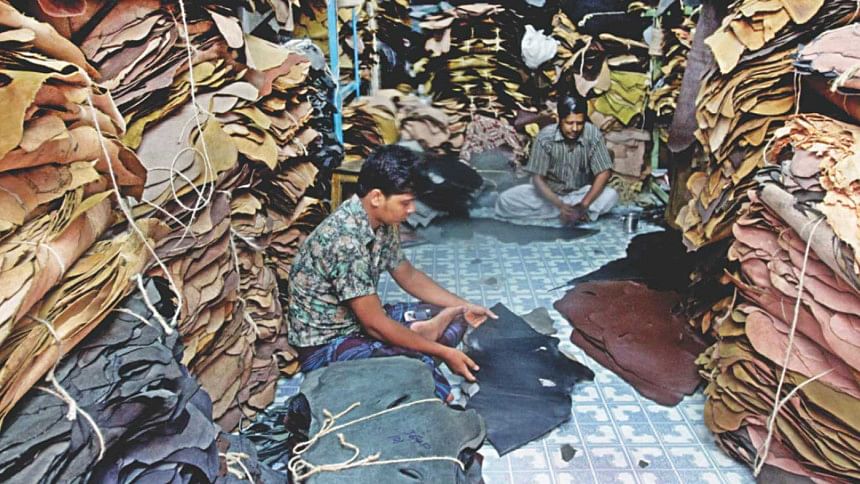Leather goods: Relocation issue

Bangladesh’s effort to emerge as a major leather products exporting nation is not getting momentum due to long dilly-dallying over the relocation of polluting tanneries from the capital to Savar.
The move to shift hazardous tanneries from Dhaka's Hazaribagh to Savar took off in 2003, but it did not become a reality in the last one decade mainly due to the procrastination on the part of the tanneries.Their reluctance even prompted the government to threaten them with cancellation of the allotment of plots it has distributed to the tanneries.
Tanners now say that the June 2015 is a difficult deadline to meet for tannery relocation mainly due to shortage of fund and time span. However, Industries Minister Amir Hossain Amu has already warned against delay in relocation, threatening to cancel the plot allotment for those who do not meet the deadline. The parliamentary standing committee on the industries ministry also echoed the same.
“We need soft loan for relocation as tanners are going through liquidity crisis,” says Md Shaheen Ahmed, chairman of Bangladesh Tanners Association (BTA). Tannery owners will have to invest around Tk 5,600 crore to establish new plants and begin commercial production, he added.
“We are sincere in our efforts to relocate tanneries soon. But we need access to low-cost funds as leather is a capital-intensive industry,” said M Abu Taher, chairman of Bangladesh Finished Leather, Leather Goods and Footwear Exporters' Association. He called upon the government, especially Bangladesh Bank, to take necessary steps to arrange soft loans for the tanners.
Shaheen Ahmed said most tannery owners will be able to start the relocation if the government arranges loan at a 5 percent interest rate and disburses the compensation money of Tk 250 crore immediately. Some analysts however said demanding soft loan is a weak excuse to delay the tannery relocation further.
The government has already provided a number of incentives to tanners such as allotting plots at subsidised rates, giving out power and gas connections and bearing the construction cost of the central effluent treatment plant at the new Savar Leather Industrial Park, they said.
The industries ministry has already allocated plots on the 200-acre leather estate to 155 tannery owners through Bangladesh Small and Cottage Industries Corporation, a wing of the industries ministry that is implementing the project.
Some 148 tannery owners have so far begun building their factories in Savar, according to Md Sirajul Haider, project director of the Industrial Estate.“But most tanners have so far only built boundary walls and guard sheds,” he said adding that just 40 companies have made multi-storey buildings at the estate.
Some industry people says the industries ministry has made a mistake in the case of allocating plots in the Savar Industrial Estate as it has distributed plots only to those who have tanneries in Hazaribagh. “Tanner relocation would have been much earlier if the government kept plots open for all,” said a noted leather goods exporter wishing not to be named.
Saiful Islam, senior vice president of Leather Goods and Footwear Manufacturers and Exporters Association of Bangladesh, said tanneries need to be relocated as soon as possible for the sake of the environment and exports. Many international buyers are not giving orders to Bangladesh mainly due to a long delay of the tannery relocation, said Islam, also managing director ofPicard Bangladesh, a leading leather goods exporter.
"Bangladesh will be able to earn at least USD 5 billion in exports from leather, leather goods and footwear annually by 2018 if it can properly address environment and compliance issues and give policy support for higher value added products in the sector by this year," he said. The leather sector is quite similar to the garment sector, but the scope of value addition is far greater.
The value addition in the sector is close to 90 percent as opposed to 40 percent in the garments sector, said Sobur Ahmed, an assistant professor of the Institute of Leather Engineering and Technology.
The industrial estate project took off in 2003 with a Tk 175.75 crore fund, and the cost has gone up by 98 percent to Tk 1,079 crore over the decade since its launch. The amount includes Tk 250 crore as government compensations to the tanners.
Initially, it was planned that the 155 tanneries would finance 60 percent of the costs and the government the rest. Later the government has agreed to bear 80 percent of the core project cost: Tk 829 crore.
Bangladesh has a long history of leather business. The country's first tannery was set up at Narayanganj in 1940s, and large scale production started in 1970s. The country has now some 3,500 micro, small and medium enterprises and 110 large firms in the sector. About 95 percent of leather and leather products are sold abroad, said Islam of Picard Bangladesh.
The country has now around 50 foreign footwear and leather goods companies. Their investment totals USD 210 million, and they have created jobs for 30,342 local people.
Bangladesh exported USD 662.88 million in leather, leather goods and non-leather footwear between July and December last year, up 6.85 percent year-on-year, according to the Export Promotion Bureau. The sector's exports rose 32.12 percent year-on-year to a record USD 1.29 billion last fiscal year.
Of the total exports from the leather industry, 60 percent go to the European Union, 30 percent to Japan and 10 percent to the rest of the world, according to industry insiders.
The industry, which has grown on local raw materials, has emerged as the second largest export earner after garments. Bangladesh's leather exports however account for just 0.56 percent of the global leather and leather goods market worth around USD230 billion.
..............................................................
The writer is a business reporter, The Daily Star.

 For all latest news, follow The Daily Star's Google News channel.
For all latest news, follow The Daily Star's Google News channel. 



Comments